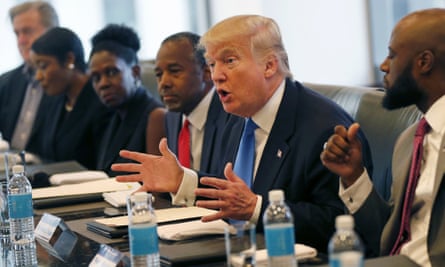Immigration
“They’ll pay back taxes, they have to pay taxes, there’s no amnesty, as such, there’s no amnesty, but we will work with them” – 24 August, to Sean Hannity, Fox News.
Last summer, Donald Trump burst into the political ring with a fiery proposal to build a “great, great wall” along the US-Mexico border – paid for by Mexico. An ultra-hardline stance on immigration has remained at the heart of his campaign, though reporters have had a notoriously difficult time pinning him down on what he actually proposes to do to or with the estimated 11 million undocumented migrants who currently live in America. He has suggested a “deportation force” to remove them.
“We’re rounding ’em up in a very humane way, in a very nice way. And they’re going to be happy because they want to be legalized,” Trump told CBS last September. “And, by the way, I know it doesn’t sound nice. But not everything is nice.”
On Saturday, after meeting with his Hispanic advisory council, reports emerged that the Republican candidate was softening his stance. The next day, newly installed campaign manager Kellyanne Conway appeared to waffle on whether Trump was still committed to deportation. In an interview with Fox News, Trump himself denied that he was “flip-flopping”. To gain more time to fine-tune, the campaign postponed a speech he was due to give on Thursday.
On Wednesday, Trump said immigrants not in the US legally would not get citizenship – but also appeared to offer a path a forward and to contradict his previous promises that undocumented migrants would be deported.
“They’ll pay back taxes, they have to pay taxes, there’s no amnesty, as such, there’s no amnesty, but we work with them,” Trump said in a town hall with Fox News anchor Sean Hannity. The next morning, he met African American and Latino activists at Trump Tower in New York.
Such apparent moderation on immigration comes as Trump tries to aggressively court Hispanic and African American voters. Polling shows Trump trailing Hillary Clinton. A Quinnipiac University poll released on Thursday gives Clinton a 62-point lead over Trump among likely non-white voters.

War zones are safer than America’s inner cities
“The Democrats have failed completely in the inner cities. For those hurting the most who have been failed and failed by their politicians – year after year, failure after failure, worse numbers after worse numbers. Poverty. Rejection. Horrible education. No housing, no homes, no ownership. Crime at levels that nobody’s seen. You can go to war zones in countries that we are fighting and it’s safer than living in some of our inner cities that are run by the Democrats. And I ask you this, I ask you this – crime, all of the problems – to the African Americans, who I employ so many, so many people, to the Hispanics, tremendous people: what the hell do you have to lose?” – 22 August, speech, Akron, Ohio
There’s a lot to unpack in this statement. At best, Trump is offering a broad-brush portrait of America’s cities and at worst he’s using language that is offensive to the very voters he’s trying to reach.
Trump also claims crime is at “levels that nobody’s seen”. Based on the context and past statements about crime statistics, we can assume he means crime is at record heights. But this bleak picture of crime-ridden American streets more dangerous than parts of the world where the US is engaged in military action, such as Afghanistan and Iraq, runs counter to a trend of declining crime that has persisted for more than a quarter of a century.
Though crime statistics are notoriously ripe for manipulation, studies show a steady decline since 1991. Particular demographics, particularly low-income areas, do continue to show high rates of criminal activity.
Trump also claims to employ “so many, so many” African Americans in his various businesses. However, a June analysis by the Associated Press found “few if any” black executives in the upper echelon of Trump’s organization.
Trump has recently dialed up his outreach to African American voters, but he delivers his speeches before largely white audiences. A recent NBC/Wall Street Journal poll showed Trump receiving the support of only 1% of African American voters.
African American unemployment
“Look at how much African American communities are suffering from Democratic control … 58% of your youth is unemployed, what the hell do you have to lose?” – 19 August, Dimondale, Michigan
Trump and his campaign raised eyebrows when they repeated this eye-popping statistic: that more than half of young black men and women are unemployed.
The latest figures from the Bureau of Labor Statistics (BLS) put the unemployment rate among 16- to 19-year-old black Americans at 25.7%, adjusted seasonally. So how did he get to 58%?
The campaign’s economic adviser, David Malpass, told ABC News it began with BLS data from 2015 and broke out the numbers for 16- to 24-year-old African Americans. As part of its calculation, the campaign included labor force participants and those outside the labor force, including people who have no job or are not looking for one, such as students and retirees. These are sectors of the population the federal government does not count as unemployed.
The campaign then divided the larger number by the population of the 16-to-24 age group to reach 58.5%, ABC reported. Economists have said it is statistically misleading to include segments of the population that are actively not seeking employment.

Comments (…)
Sign in or create your Guardian account to join the discussion